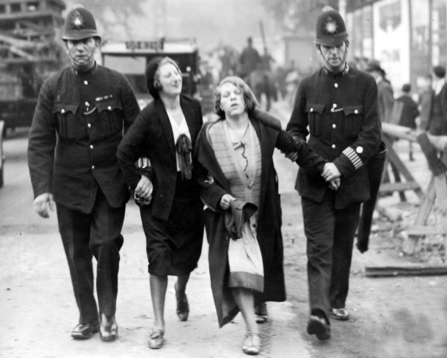Back

Collections
Suffragette Collection
This collection comprises records from The National Archives related to the women and men who supported women's suffrage in the early 20th century. Among them there are arrest records, parliamentary papers, personal statements, reports of forcefeeding, transcripts of speeches and a watch list of over 1,300 suffragettes.

- Date range
- 1902-1919 (with additional materials 1894-1936)
- Records
- 78,272
- Images
- 6,697
About this collection
Suffragettes advocated for the right to vote to be extended to women. The term ‘suffragist’ was a general term for those who supported women’s suffrage, and the term ‘suffragette’ was coined in 1906 by the Daily Mail to distinguish those who advocated the use of militant tactics to win the right to vote.
These records span 1902 to 1919. They include photographs of suffragettes, cabinet letters, prisoner calendars, Home Office papers, an index of women arrested between 1906 and 1914, reports of force-feeding and more.
The women’s suffrage movement began in the late 19th century and became a national movement with the formation of The National Society for Women’s Suffrage in 1867 by Lydia Becker. Later came the more influential National Union of Women’s Suffrage Societies, created under the leadership of Millicent Fawcett. A significant shift in the suffrage movement occurred in the early 20th century, when more suffragists supported militant action after being disappointed with years of no progress. In 1906, Emmeline Pankhurst and her daughters Christabel and Sylvia established the Women’s Social and Political Union. The motto of the organisation was ‘Deeds Not Words’.
The women’s suffrage movement succeeded in influencing the passage of two pieces of legislation which extended the franchise to women. The Representation of the People Act 1918 extended the right to vote to women over the age of 30 who met certain property qualifications. The Representation of the People (Equal Franchise) Act 1928 expanded the vote to all women over the age of 21, bringing the right to vote for women in line with men.
The collection brings together the stories of women of all classes who actively supported women’s suffrage in a variety of ways: attending peaceful demonstrations, committing arson attacks and public disobedience, breaking windows, chalking on footpaths, and more. You will find working-class women alongside aristocratic women in these records. They also include the names of male suffragettes who were arrested alongside their female comrades.
There are numerous well-known names of suffragettes found in these records. Below is just a selection of the notable names:
- Emmeline, Christabel, and Sylvia Pankhurst – leaders of the women’s suffrage movement. Founded the Women’s Social and Political Union and supported the militant actions of suffragettes.
- Leonora Cohen – acted as the personal bodyguard for Emmeline Pankhurst and was arrested after smashing the display case of the Crown Jewels at the Tower of London, an action which gave her the nickname the ‘Tower Suffragette’.
- Emily Wilding Davison – Davison was arrested on nine occasions, commenced a hunger strike in prison, and was force-fed. One of her arrests was, famously, for hiding overnight in Parliament on the same night the 1911 Census was recorded. In 1913, she was killed by King George V’s horse after walking onto the track at the Epsom Derby.
- Marion Wallace Dunlop – the first suffragette to go on a hunger strike while in prison.
- Flora McKinnon Drummond – given the nickname ‘the General’ for the way that she led women’s marches. Drummond was arrested nine times and was a frequent speaker at demonstrations.
- Mary Eleanor Gawthorpe – arrested when she interrupted Churchill’s speech in 1909, Gawthorpe was badly beaten while imprisoned and suffered internal injuries.
- Lilian Ida Lenton – arrested for arson at the Tea House at Kew Gardens. Lenton escaped Holloway prison by dressing as an errand boy and fled to France.
- Lady Constance Lytton – arrested and force-fed while on hunger strike. Lady Lytton used the alias Jane Warton in order to avoid special treatment because of her title.
- Hannah Mitchell – involved with the Women’s Social and Political Union. Her autobiography The Hard Way Up was used by Abi Morgan, the screenwriter of the 2015 film Suffragette, as inspiration for one of the film’s working-class characters.
- George Lansbury – a political and social reformer. Lansbury represented the East End of London and promoted social justice and women’s rights. His name is listed among the index of suffragettes.
- The National Archives, Kew, London, UK
Record series includes
The Suffragette
This collection also includes The Suffragette newspaper. The Suffragette (later named Britannia) was a weekly newspaper announcing the activities of suffragettes, upcoming meetings, and articles related to a wide range of women’s issues. The paper had a circulation of 40,000. The collection holds newspapers from 1912 until 1918. The Suffragette, and then later Britannia, was edited by Christabel Pankhurst and was the official organ of the Women’s Social and Political Union (WSPU). The WSPU was formed in 1903 by the Pankhurst family and became known for its emphasis on militant action and its motto: ‘Deeds not Words’. In 1915, the newspaper title changed its name to reflect the WSPU’s patriotic ideals and was used to campaign for the war effort while retaining a focus on women’s issues.
With each issue, you will discover the efforts by the WSPU towards women’s suffrage and in support of the Allies and the First World War. In the early years of the newspaper, before the Pankhursts vowed to set aside their militant actions to support the war, the articles told of the violent and disruptive actions of the suffragettes. The paper also featured articles on a range of topics affecting the women of Britain.
Try the Social History Archive.